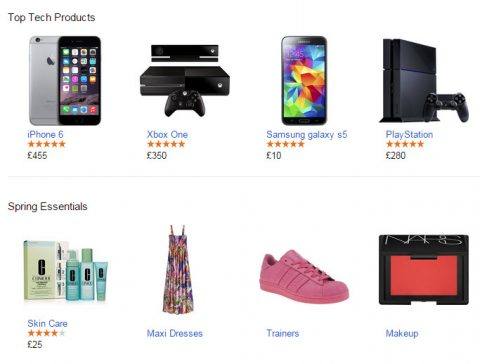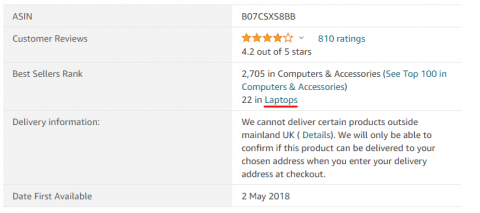Ecommerce SEO is one of the trickier forms of SEO to master, as it often relies heavily on technical SEO optimisations and copious amounts of link building to rank above larger, more established brands such as Amazon. In this SEO Checklist, we’re going to provide you with everything you need to do in order to start growing your store online with SEO.
1. Optimise Your Site For Crawling
Like every crawler, Google has a set amount of URLs that it can discover, crawl and index within a set period of time. This means that when you’re trying to rank your eCommerce website you need to make sure that you’re making effective use of your website structure, to exclude any URLs that are either duplicated, filtered versions of category pages, or thin content pages.

This can usually be done with the effective use of noindex and canonical tags in combination with a robots.txt file that excludes any unnecessary URLs. By doing so, you’re sculpting the way in which Google crawls through your site and discovers your content so that your most important, regularly-updated pages are being re-crawled as often as possible.
Now more than ever, Google is becoming slower and pickier about the pages it decides to index. Therefore, you want to get the most out of your site by having fewer high-quality pages as opposed to thousands of filtered, thin pages.
That’s not to say that your site shouldn’t have lots of pages though, we just need to ensure that the pages that are on the site are all high-quality, unique pages with their own specific content.
You should also consider uploading an XML sitemap to Google Search Console, along with an HTML sitemap on the footer of your site.
2. Create Category Pages Based On Product Range And Keyword Research
Category pages (or collection pages, as they’re referred to on Shopify sites), are the backbone of any successful eCommerce website. They allow both users and crawlers to come through your site and discover the various product pages that you have on the site, without simply parsing through hundreds of ‘next page’ tabs.
By separating your products out into categories, sub-categories and sub-sub-categories, you’re building an association between topically-associated products on your site.
In order to have the best chance at ranking effectively online, you need to ensure your eCommerce website is appropriately sectioned up into categories that reflect your core products.

The key point here is that the more specific you can be with your sub-categories, the more likely you are to rank for your target keywords, as these will have less competition.
Granted, these long-tail keywords will have less search volume than your top-level product categories, but the conversion rate of these searches is actually much higher. Think about it – if someone searches for “Shoes” are they more or less likely to make a purchase than someone who searches for “Men’s Nike Running Trainers”.
The answer is clear, so it’s crucial to make sure that your keyword research digs deep into all of the possible ways that your customers are searching for your products. From there, you can begin to remove any searches that are irrelevant and you can double down on the less-competitive, high-buyer intent sub-categories.
3. Use The ‘Middleman Link Building’ Technique To Power Up Category Pages
The previous step in our checklist will allow you to rank for less-competitive keywords with your category pages. However, in order to ever compete for the more competitive, broad search terms you’re going to have to invest some time into building links to your site. It’s one of the least favourite SEO activities for many businesses, as it’s incredibly time and resource-intensive.

You’ll usually find that if you want to build links directly to your category pages, you’ll be met with a wall of email responses requesting payment in order to get the link live on their site. There’s a clear commercial intent behind your need for a link, and webmasters understand the value of a link, so why would they link to your category page for free? The short answer is, they won’t.
So how do we get around this…?
Enter… the ‘Middleman method’ for link building.
This is a technique that has become more popular in recent years, particularly with the video tutorials and articles by Ahrefs on this topic. So how does it work?
The ‘Middleman method’ is a way of building authority to your category pages, without actually needing to build links directly to the pages themselves. Instead, we use the blog as a way to create linkable assets, useful resources and newsworthy content that internally links to your relevant category pages.
So what might an example of this look like?
If you have an eCommerce website that sells shoes, and you want to build links to your “Running Trainers” category page, you could write a blog post sharing an extensive guide on how to go from no running experience to running a marathon. Within this article, you can reference how important it is to have the right running shoes, and hence, you can internally link to your running shoe category page with targeted anchor text.
Websites are far more likely to link to a useful guide such as this, both through email outreach and gaining links naturally over time. Whilst it does require some initial resources in the short term to build such a content asset, it’s a worthwhile investment as it’ll help to push your category pages higher in the search results over the long term.
4. Use Internal Links To Create A Silo Structure
Whilst we’re on the topic of internal linking, it’s also crucial that you’re internally linking between your related categories, products and blog posts. This helps Google to crawl through your site to get a better understanding of which products and categories are closely related to one another, whilst also benefiting the user experience, average session duration and average page views for your site.
Our recommendation is to link from top-level categories down to your sub-categories from within the category text (often just above the product list). So, within the ‘Shoes’ category, you might discuss running trainers, smart shoes, casual shoes etc. All of which are internal links to those sub-categories. You can see this exact setup here with ‘Office’ who are ranking high for the very broad keyword ‘Shoes’:

You can take this a step further by including relevant internal links from your product pages, back up to the subcategory and category pages. You will have seen this before on Amazon’s product pages, where they include an auto-generated link back up to the category:

Supporting Your eCommerce Growth
So there you have it – 4 surefire ways to optimise your eCommerce store with SEO. Here at Koozai, we’ve worked with countless eCommerce sites to help them smash their online growth targets so if you’d like some help increasing your organic sales through eCommerce SEO, why not get in touch for a chat?





